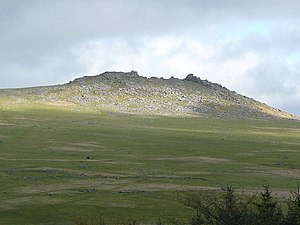Rough Tor
| Rough Tor | |||
| Cornwall | |||
|---|---|---|---|

| |||
| Range: | Bodmin Moor | ||
| Summit: | 1,313 feet SX147805 50°35’41"N, 4°37’10"W | ||
Rough Tor or Roughtor, is a hill on Bodmin Moor, Cornwall, capped with a granite outcrop. Its summit is 1313 feet above mean sea level, making it the highest point in Cornwall after neighbouring Brown Willy.
The summit is composed of the tor summit and logan stone. On the slopes of the hill are found a neolithic enclosure, a large number of Bronze Age hut circles, and some contemporary monuments.
Rough Tor is found about a mile north-west of Brown Willy, Cornwall's highest point. The De Lank River, which rises in the vicinity and flows between the two hills.
Rough Tor and Little Rough Tor are twin summits of a prominent ridge of granite, though there are actually three rock formation ("tors") at the site, known as Showery Tor, Little Rough Tor, and Rough Tor. On the summit is a Logan Rock, which gently rocks back and forth when pressed.
Crowdy Reservoir and the Lowermoor Water Treatment Works are not far away from the hill.
Contents
Ascent
The most readily accessible approach is from the road up from Camelford, in north Cornwall. The road runs up to a car park which looks straight on to Rough Tor, and a path leads part of the way to the tor.
From the top of Rough Tor, Brown Willy appears, Cornwall's county top, and it is common to take both hills in on the same walk. Below Rough Tor a path leads across the small De Lank River and up Brown Willy. From there a walk can be completed to Jamaica Inn at Bolventor.
An alternative route is from Jamaica Inn, over Tolborough Tor and on to Brown Willy and Rough Tor.
Historical interest
From the summit of Rough Tor, many signs of settlements and field systems are visible, indicating that it was a well populated area in former times.
Neolithic
The summit of Rough Tor once had a neolithic enclosure. The summit is encircled by a series of rough stone walls that align with natural stone outcroppings on the tor. The walls would have originally completely encircled the tor. The walls would have had numerous stone lined openings. In the interior of the circle there are remains of terraces levelled into the slopes, which archaeologists believe formed the foundations of circular wooden houses.[1] There are also cleared areas near the terraces that have been garden plots.
Bronze Age
The Rough Tor enclosure is located in an area containing a remarkable concentration of upstanding monuments and other Bronze Age sites, such as Fernacre stone circle, which is only 200 yards from the site. Stannon stone circle is also located nearby, and there are numerous cairns and burial monuments in the vicinity.
On the southern slopes of Rough Tor, there are the remains of a large number of stone hut circles, set around three or four enclosures that may have held stock. There are also the remains of a large field systems, which is partially overlain with a mediæval field system. The purpose of this field system has been debated, with historians disagreeing as to whether the fields were used for cereals or for stock.[2]
Mediæval
The summit of the tor was once the site of a mediæval chapel, which was built into the side of one of the cairns, and was dedicated to St Michael. The chapel was recorded in the 14th century, and is the only known hilltop chapel in Bodmin Moor. As it overlooks an ancient trackway across the moor, it may have served as a guide for travellers. There are remains of a second mediæval building at the bottom of the summit, and a beacon may have been maintained here or at the summit by a hermit.[3]
A mediæval field system based on straight lines overlays the Bronze Age field system at Rough Tor, and several mediæval artefacts have been found in the area, such as the base for a stone cross, and a small stone cross.[4]
Contemporary
A memorial stands below Rough Tor, commemorating the men of the 43rd (Wessex) Division who lost their lives in the Second World War. It records that Rough Tor had been given to the nation in memory of those who lost their lives serving in the Division on the Western Front in 1944-1945.
There is also a memorial to Charlotte Dymond, who was murdered on the Tor in 1884.[5]
In a programme shown in 2007 Channel 4's Time Team investigated a large cairn and the site of a Bronze Age village on the slopes of Rough Tor.[6]
Miscellany
There is also a Rough Tor on Dartmoor in Devon, three miles west of Postbridge.
References
- ↑ "Rough Tor". http://www.historic-cornwall.org.uk/a2m/neolithic/tor_enclosure/roughtor/roughtor.htm.
- ↑ "Rough Tor Settlement (South)". http://www.historic-cornwall.org.uk/a2m/bronze_age/hc_settlement/roughtor_s/roughtor_s.htm.
- ↑ "Rough Tor". http://www.historic-cornwall.org.uk/a2m/neolithic/tor_enclosure/roughtor/roughtor.htm.
- ↑ "Rough Tor Settlement". http://www.historic-cornwall.org.uk/a2m/bronze_age/hc_settlement/roughtor_s/roughtor_s.htm.
- ↑ "Bednobs and Breakfast Rough Tor". http://www.bedknobs.co.uk/bedknobs-bodmin-moor-roughtor.htm.
- ↑ "Bodmin Moor, Cornwall". Channel 4: Time Team. 8 April 2007. http://www.channel4.com/history/microsites/T/timeteam/2007_bod_found.html. Retrieved 2009-11-09.
Outside links
| ("Wikimedia Commons" has material about Rough Tor) |

